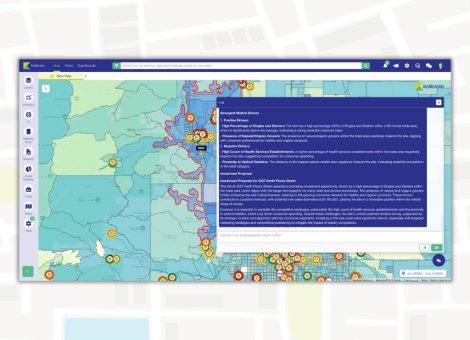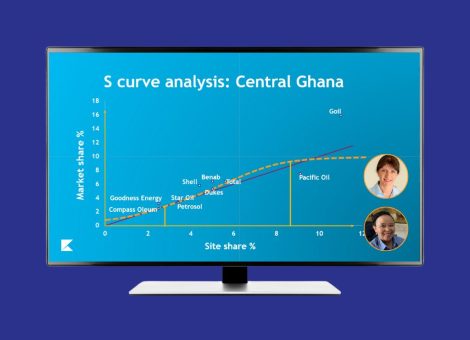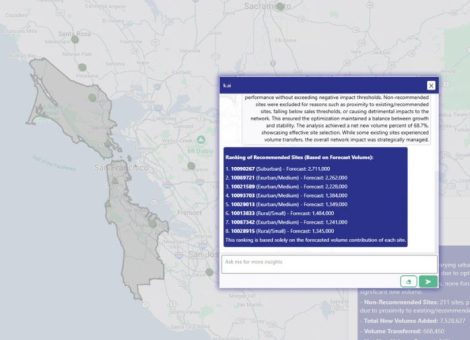Making the business case for improved tools
Every day we talk to retail-based companies about how to improve their tools and systems for site selection and real estate management. Many are using tools they’ve had for years and they feel it’s time to review what’s now available to them. Others are still using a mostly manual process with critical data floating around in Excel spreadsheets or disparate platforms.
There are a variety of reasons to consider a change or upgrade. Among those are a need for great data centralization, more exposed analytics and modeling, or delays in service or requests from support, bottlenecks in the real estate process slowing the team down, or overall sub-par site selection results. Whatever the reasons, the range of tools on the market is constantly evolving and worth regular review to be sure you’re using the platform best designed to help your teams be successful.
One of the critical components of systems review and potential upgrades always comes down to internal buy-in. Occasionally, a team of real estate research professionals seeks out new tools and data, only to find out there is not yet an appropriate appetite internally for a change or increase in investment. Sometimes it’s simply an “if it isn’t broken, don’t fix it” mentality, and other times it may be “they’re all the same so what difference does it make?”.
Kalibrate has many staff who’ve previously worked client-side, managing real estate strategy and making location decisions daily, so we recognize the challenges you’ll face. But we also understand the best ways to make the business case for investment in location intelligence tools.
Understanding ROI
Putting things in terms executives understand is critical. Can you properly assess the strengths and weaknesses of your current tools? What do those weaknesses or deficiencies mean to your team and KPIs? One example may be data that’s difficult to update and access – does that lead to missing out on prime locations due to competition for the site? Or does the job of site assessment, whether for a new location or existing store decisions (reinvest, relocate, renew, consolidate, close, etc.) fall on the shoulders of one or a few market researchers who are understaffed? Does that interfere with your ability to make fast, accurate decisions? And how about analytics? Do your existing models provide forecasts that can be trusted? Can you explain how they come to certain conclusions and what the data being used shows? We talk to many professionals who tell us data integrity and the ability to defend forecasts are more crucial than ever in their roles.
Once you can explain what limitations you face, and how they affect you, your team, and the company’s goals, it becomes easier to explain ROI in clear terms. Kalibrate clients report, on average 3x increase in productivity, 4x improvement in real estate committee approval ratio, 90% reduction in dead deal and related real estate costs, and payback period (ROI) measured in just weeks. They can give us this data because they understood the impacts of previous tools/systems/processes and could measure the differences. An effective argument to support your need for improved data, tools, and even processes is always stronger with associated metrics – even based on just potential outcomes.
Reducing risk
There are many types of risks in real estate decision-making. Choosing a poor location or making a poor choice on an existing portfolio asset becomes easy to spot in time with sales and/or profits below expectations.
Location decisions come with multimillion-dollar price tags, and long-term lease obligations. So why are some companies resistant to investment in the right tools and data to get more of those decisions right? Hard to say – but it’s likely that the executives concerned do not fully understand the extent to which having robust site selection tools and analytics can mitigate these risks.
Sharing with them specifically how better, updated, and centralized data along, with tools for collaboration, can impact these decisions will help. Even better, quantify it further by illustrating how many location decisions don’t meet expectations and presenting how an improvement in those statistics can impact the bottom line.
Another risk element we’re seeing talked about much more often is IT’s interest in security and some of the risks of sharing Excel reports via email. Excel is, and will continue to be, an important tool for us all – but when proprietary data about sales, leases, and more is routinely shared via Excel, many CIOs take notice. Employing a system to reduce the need to share via Excel, , can alleviate some of those security risks, which any IT will appreciate.
Growth and bottlenecks
We see this a lot – whether about new store growth strategies or portfolio optimization decisions in which you have a large number of stores and leases to consider. Many companies face bottlenecks in their key processes due to system limitations or required tasks put on a few people’s shoulders.
We can all only do so much in a day, and if you don’t have tools that can both prioritize deals and automate processes, you may be at risk now or in the future. Those risks are two-fold: one missing out on opportunities as the real estate landscape changes more than ever and is incredibly competitive, and two if one or a few key people are relied upon to keep the decision process moving were to leave, what then?
Considering tools and systems to remove the burdens from a few people and automates much of the analytics around what data and insights will help you determine a good decision on any location. What’s more, it’s more important than ever as the speed of real estate decision-making continues to increase.
Many Kalibrate clients use the tools to quickly identify locations that either don’t fit key criteria or no longer do so under such rapidly changing dynamics, allowing them to focus on the best sites. Removing locations from your pipeline that would never make it through real estate committee early in the process can significantly reduce your bottlenecks and increase efficiencies. We’ve had several clients reduce their pipelines by a factor of 10 quickly eliminating sites that don’t fit, and focusing on those that do, allowing them to secure those locations and improve their portfolio.
‘We don’t need it’
At Kalibrate, we work with businesses in retail, restaurant, convenience, grocery, pharmaceutical, service, entertainment, and everything in between. A good location strategy supports decision making beyond the real estate department – from helping a marketing team position the brand appropriately, to helping your sales operation determine the right product set for the consumer at each site.
Fact of the matter is that if you’re not using all the tools and insight available to support your decision making, you’re sacrificing competitive advantage – and that alone should be sufficient to get buy-in from even the most resistant stakeholders.
Read more articles about:
Location intelligenceSubscribe and get the latest updates
You may unsubscribe from our mailing list at any time. To understand how and why we process your data, please see our Privacy & Cookies Policy
Related Resources
Location intelligence
AI in location intelligence: See it in action
See videos and screen captures of how AI has been integrated into the KLI platform.

Fuel pricing
Middle East / Africa - Fuel network planning: Critical insights
Join our team as we look at the key points of insight that fuel network planners need to consider when making...

